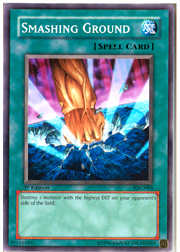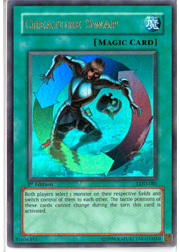

|
Doomkaiser Dragon
Card# CSOC-EN043


Doomkaiser Dragon's effect isn't just for Zombie World duelists: remember that its effect can swipe copies of Plaguespreader Zombie, too!
Click here for more
|
|
|

|
|
|

|
|
 |
 |
  |
| Single Cards in the Metagame: The Spells |
| Jason Grabher-Meyer |
| July 29, 2004 |
|
|
| |
Every big tournament has its own unique qualities. Maybe it’s play tendencies: Were the players conservative in spending their hands, or did they each drop three or four cards on turn 1? It can sometimes be a matter of decks: Was there one deck that made a prominent showing at the event that usually isn’t seen in such quantity? Often, though, the most reliable source of uniqueness at a major tournament is on the micro-level, with individual cards acting as tiny finger prints, making the event stand out. The 2004 Yu-Gi-Oh! World Championships were certainly no exception, as several cards saw a spike in popularity far greater than they normally experience.
 Six cards stood out from the usual fare, three spells and three monsters. All were played with good reason. The standout spell cards were Smashing Ground, Creature Swap, and Card Destruction. Six cards stood out from the usual fare, three spells and three monsters. All were played with good reason. The standout spell cards were Smashing Ground, Creature Swap, and Card Destruction.
Smashing Ground was one of the biggest surprises of the six. For those unfamiliar with it, it’s a normal spell card that destroys the monster with the highest DEF on your opponent’s side of the field. Think of it as a reverse Fissure. While traditionally it hasn’t seen much play in the past due to the fact that in most cases, the monsters with the best ATK have comparatively low DEF, it can do some serious damage when one is facing off against a Chaos deck. Chaos Emperor Dragon - Envoy of the End and Black Luster Soldier - Envoy of the Beginning both have high enough DEF to automatically render them the hands-down target for a Smashing Ground if either of them is on the table, and having a one-card answer to the two game-winning monsters is a huge asset. Beyond that, D. D. Warrior Lady generally has higher DEF than all other level 4 or lower monsters in a Chaos deck and can often be the most problematic monster in existence, so being able to take it out in the early game is great as well.
Beyond the fact that it’s a nice piece of anti-Chaos tech, Smashing Ground’s true worth lies in its utility—as long as your opponent has a face-up monster card in play, Smashing Ground is going to be useful. It’s hardly ever a poor draw, and unlike Fissure, which one often finds targeting a Magician of Faith or Sinister Serpent while an opponent’s real threats continue hammering away at you, Smashing Ground is always going to be taking out something of at least moderate value. There just isn’t a high-DEF card being played heavily in any metagame in North America that isn’t a worthwhile, bothersome card. Watch for Smashing Ground to become a popular choice all over North America, as the World Championships really demonstrated this card’s power.
 Next up: Creature Swap. Though Creature Swap has been a semi-popular card for Control decks in the past, it’s generally not been used in Chaos decks due to deck size concerns. This wasn’t the case at Worlds though, as many players used a single copy of Creature Swap (often side decking a second, and sometimes even main decking two) to get the most out of their monsters. It’s no wonder why the card was played; with Change of Heart removed from the environment, players looked for a suitable replacement and the options were Enemy Controller, Creature Swap, or both. Many duelists used Enemy Controller, but Creature Swap took advantage of some of the Chaos deck’s natural resources. In a standard Chaos deck, there are lots of things that are strategically beneficial to Creature Swap to your opponent. Witch of the Black Forest, Sangan, Mystic Tomato, Shining Angel, and Sinister Serpent were all popular cards, and Scapegoat tokens were also frequently passed along in order to take control of a real monster from an opponent. Creature Swap provided a lot of field disruption, potential hand advantage, and in the case of Mystic Tomato and Shining Angel, the ability to potentially replace up to two monsters on the field with new ones that are more to your liking. Creature Swap backed a lot of the winning plays at the 2004 World Championships. Next up: Creature Swap. Though Creature Swap has been a semi-popular card for Control decks in the past, it’s generally not been used in Chaos decks due to deck size concerns. This wasn’t the case at Worlds though, as many players used a single copy of Creature Swap (often side decking a second, and sometimes even main decking two) to get the most out of their monsters. It’s no wonder why the card was played; with Change of Heart removed from the environment, players looked for a suitable replacement and the options were Enemy Controller, Creature Swap, or both. Many duelists used Enemy Controller, but Creature Swap took advantage of some of the Chaos deck’s natural resources. In a standard Chaos deck, there are lots of things that are strategically beneficial to Creature Swap to your opponent. Witch of the Black Forest, Sangan, Mystic Tomato, Shining Angel, and Sinister Serpent were all popular cards, and Scapegoat tokens were also frequently passed along in order to take control of a real monster from an opponent. Creature Swap provided a lot of field disruption, potential hand advantage, and in the case of Mystic Tomato and Shining Angel, the ability to potentially replace up to two monsters on the field with new ones that are more to your liking. Creature Swap backed a lot of the winning plays at the 2004 World Championships.
 Lastly, with Painful Choice banned from the tournament, players needed a replacement. The goal of replacing Painful Choice would be two-fold. First, it would have to provide a way to discard monsters in order to get Lights and Darks into the graveyard to aid in summoning Chaos monsters. Also, the replacement would have to effectively replace itself with a potentially better card. Card Destruction filled both these needs, so several players used it, mostly with a good amount of success. It isn’t quite as useful as Painful Choice in most cases, but it is superior in two situations. First, when a player needs to change more than one card in his or her hand, it’s definitely a great play. Second, though, pitching an entire hand for a new one thins the deck significantly and allows a duelist to immediately draw into a Chaos Emperor Dragon or Black Luster Soldier—that’s something that Painful Choice can’t do. It can thin your deck by five cards, but it can’t actually get you to the Dragon or Soldier. Combined with an abundance of Mirage of Nightmare, the environment at Worlds 2004 was scorchingly fast, with many games ending by turn 4 or earlier. Card destruction actually caused a few first turn wins, with a Dragon or Soldier making it to the field, followed up by a Monster Reborn and a Premature Burial. Card Destruction made Chaos even more reliable to play with and unpredictable to play against. Lastly, with Painful Choice banned from the tournament, players needed a replacement. The goal of replacing Painful Choice would be two-fold. First, it would have to provide a way to discard monsters in order to get Lights and Darks into the graveyard to aid in summoning Chaos monsters. Also, the replacement would have to effectively replace itself with a potentially better card. Card Destruction filled both these needs, so several players used it, mostly with a good amount of success. It isn’t quite as useful as Painful Choice in most cases, but it is superior in two situations. First, when a player needs to change more than one card in his or her hand, it’s definitely a great play. Second, though, pitching an entire hand for a new one thins the deck significantly and allows a duelist to immediately draw into a Chaos Emperor Dragon or Black Luster Soldier—that’s something that Painful Choice can’t do. It can thin your deck by five cards, but it can’t actually get you to the Dragon or Soldier. Combined with an abundance of Mirage of Nightmare, the environment at Worlds 2004 was scorchingly fast, with many games ending by turn 4 or earlier. Card destruction actually caused a few first turn wins, with a Dragon or Soldier making it to the field, followed up by a Monster Reborn and a Premature Burial. Card Destruction made Chaos even more reliable to play with and unpredictable to play against.
All three of these cards will probably see more play as a result of the results they had at the World Championship. Whether you’re playing with a forbidden list or not, all three are strong spells that deserve attention.
|
| |
| Top of Page |
|
 |
| |
 |